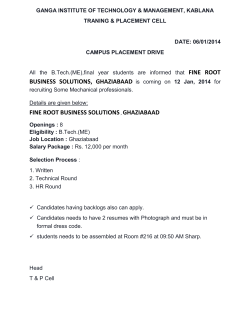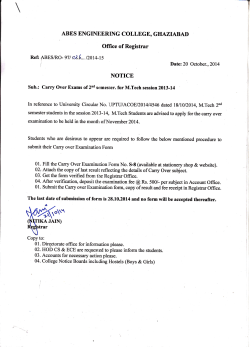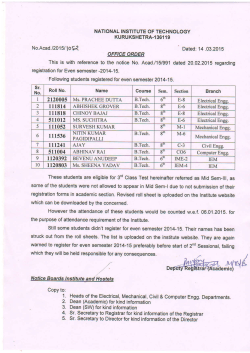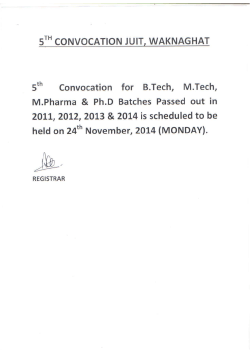
INDIA`S CHANGING - Millennium Post
2 ANNIVERSARY ISSUE INDIA’S CHANGING MEDIASCAPE F or serious news readers quickly shuffling through catchy print media headlines before reading the items they are interested in, it could be often very irritating to find the front news page buried under two or three sheets of ads. That is the way it is with many large selling newspapers, these days. Similarly, the ad interjections, often exceeding the regulated two-minute spread at a time in electronic media, cause major detraction to TV news audience. It is not that India’s media barons are unaware of the growing public uneasiness with their operational styles. But, they could be helpless. The modern media is an expensive business. Ad revenues, paid news or reader-style space or time sale are becoming important to keep the media bottom line outside the red. The bottom line has to stay in the black, at least for the long run. The exercise is not easy. Media owners know this better than most readers or viewers of the day. As a result, the control of the media is often compromised with big and regular advertisers. The latter could be the governments, central and state, industry and ruling political parties. And, the media is often forced to compromise the socalled ethical norms with relentless pressure of commerce. The likes of Mahatma Gandhi, printing and editing newspapers without solicited ads, have little space in the modern media industry. Gandhi’s early Today’s media is no longer the holy cow of previous two centuries. It is now part of a package under the banner of ‘entertainment’ industry covering a host of products such as print, television, radio, film, music, out-of-home, animation and VFX, gaming and digital advertising, says NANTOO BANERJEE nue dominates the industry. The Gandhian philosophy and canon of journalism have little relevance to the modern context. The present media scene often bristles with unheard of turmoil. Investigative journalism requires management (editorial and commercial) consent including means adopted – fair or foul. Few can deny the over-riding role of market forces that edge out strong and independent editorials by advertorial, response and response features. The media is also more into projecting celebrities, political or otherwise, and models as the icons of modern society. My days in journalism that started in Bombay in 1969 with a major multi-edition English daily can’t be compared with the experience of present day entrants. The first time I saw the employer’s name and pic. in the paper when he was arrested during the Emergency, almost six years after I joined the 20th century print media publications – Indian Opinion (in English, Tamil and Gujarati), Young India, Harijan and Navjivan – are part of the history. The modern Gandhians and social activists use social media such as Facebook, Twitter, blogs and websites to vent their views, ideas, social news and information at little cost to themselves while the service millenniumpost @3 NEW DELHI | MAY 2015 providers make money through ads posted in the system. They follow their own rules to control the posts although the service providers often grudge external control, especially from government. Today’s media is no longer the holy cow of previous two centuries. It is now part of a package under the banner of ‘entertainment’ industry covering a host of products such as print, television, radio, film, music, out-of-home, animation and VFX, gaming and digital advertising. The ad reve- SHOW ME THE MONEY newspaper outfit. Our editor-inchief used to write front-paged editorials under the banner of ‘Myth and reality’ constantly slamming the then prime minister and her party in the strongest possible language. In one such pieces, I still remember, he wrote: “The administrative machinery is hamstrung like a floating kidney in the air. Nothing moves, except the tongues of politicians.” The political and administrative atmo- sphere may not have changed much over the last four decades. But, few will have the courage to editorially express such disgust and disapprovation of the political system in the media in present times. Interestingly, I, in my near mid-20s then, was very supportive of the socialistic policies of the prime minister and enthusiastically reported government actions such as nationalization of sick mills, banks, insurance, bonus review committee proceedings, and the pro-public sector, selfreliance, pro-worker and pro-poor measures by political executives. The editor did not fiddle with factual reports. I did not lose my job for writing on even the possible defeat of my media owner at the hands of a Bidi king in Madhya Pradesh while covering Lok Sabha election prospects the state. He did lose the election. Towards the end of 1971, I was asked by the news editor to trail Jayprakash Narayan (JP) and report all his meetings for three months. JP was totally anti-PM and Cingress-I. To my surprise, I found the newspaper’s Delhi bureau chief, a Kashimiri Pandit, was absolutely pro-PM. All those did not trouble either the media owner or the editor as long as the reports were objective. Interpretative reporting was uncommon, those days. Media (only print and radio, then) was not part of the entertainment industry. Media was taken seriously as an independent opinion leader. V V Giri, who later became the President of India, Ms. Nayantara Sehgal, Pandit Nehru’s 105 Serving the nation for the past Years niece, were among regular contributors in the edit page of my newspaper. And, the media bottom line did not entirely depend on a handful of big advertisers and ruling political party satraps as the production cost was low. Morarji Desai’s nephew, Manu Desai, was among the top reporters. Ironically, he was not allowed to cover Morarji’s Congress (O). In contrast, the modern media is a serious and expensive business. Industry, government, top political entities and society know it. The CII-PwC survey titled ‘India Entertainment & Media Outlook 2014’ had forecast the industry turnover is expected to exceed Rs 227,000 crore ($36.49 billion) by 2018, growing at compound annual growth rate (CAGR) of 15 per cent between 2013 and 2018. In 2013, the business of overall entertainment and media industry was estimated at Rs 112,044 crore ($18.01 billion) and grew by 19 per cent over the previous year. India’s television industry has emerged as the largest segment. Significantly, with the increased penetration of smartphones and expansion of 3G network in India, the country is likely to see around nine billion mobile application (apps) downloads during 2015, which is five times more than 1.56 billion in 2012, as per Deloitte’s India Technology, Media & Entertainment and Telecom (TMT) predictions. This uptick in app-downloads is also expected to increase the revenue from paid apps to an estimated over Rs 15 bil- lion ($241.16 million) as against Rs 9 billion ($144.7 million) in 2014, Deloitte said. The government has allowed foreign investment in media. The DIPP data on foreign direct investment (FDI) inflows in the information and broadcasting (I&B) sector (including print media) recorded $3.9 billion between April 2000 and January 2015. Presently, there are 350 broadcasters which cater to 780 channels. “We want more competition and we wanted to open it up for the public. So far, we have approved the licences of 45 new channels. It’s a mix of both news and nonnews channels,” according to Bimal Julka, I & B Secretary, Government of India. Television and print are expected to remain the largest contributors to the advertising pie at least till 2020. Internet advertising has already emerged as the thirdlargest segment, with a share of about 16 per cent in the total M&E advertising pie. It would be foolish to imagine the growth and stability of the modern day media industry, print and others, can be had without sub-serving the interest of the key revenue sources such as industry and government, the key contributors to the bottom line. Packaging and entertainment will continue to play pivotal role in media business. The author is a senior journalist SHIATS The fear of the LORD is the beginning of wisdom. Proverbs 9-10 Established - 1910 Formerly Allahabad Agricultural Institute Allahabad -211 007, UP., INDIA Sam Higginbottom Institute of Agriculture, Technology & Sciences Deemed-to-be-University declared under section 3 of UGC Act, 1956 SHIATS DU - a Multi-Faculty 900 acre Residential Academic Institution Academic & Research Structure - 9 Faculties, 18 Schools, 58 Dept. 3 Research Centers Academic Programs - 42 Undergraduates Programs, 101 Postgraduates Programs, 16 Diploma Programs and Doctoral Programs Accreditations - NAAC with “A” grade & Indian Council of Agricultural Research Collaborations - 26 International MoU’s with Universities / Institutions from USA, UK, Netherlands, Denmark, Japan, Australia, NewZealand, China, UAE, Rwanda, Nepal, Korea etc. Eminence in Research- Patents, Research projects, Varieties of rice and wheat released and notified by Govt. of India Membership - AIU, IAUA, ACU, AIACHE, APAARI, GCHERA Hostel Facilities - 11 Hostels on Campus (6 Women, 3 Men and 2 International) ACADEMIC PROGRAMS OFFERED Engineering: B.Tech (Mechanical / Electrical & Electronics / Electronic & Comm. / Civil / Computer Science / Electrical / Environmental) BCA / M.Tech. / MCA / Ph.D. Biotechnology : B.Tech / B.Sc. / M.Tech / M.Sc. / Ph.D. Agriculture & Forestry: B.Sc. Ag. / B.Sc. Forestry / B.Sc. Horti / M.Sc. Ag. / Ph.D. Agricultural Engineering: B.Tech / M.Tech./ Ph.D. Food & Dairy Technology: B.Tech. / B.Sc./ M.Tech. / M.Sc. / Ph.D. Animal Husbandry: B.Sc. Dairying / M.Sc. Animal Sc. all branches / Ph.D. Management: BBA / B.Com. / MBA / M.Com./ Ph.D. Social Science & Education: B.A. / B.Ed. / B.P.Ed. / B.P.E. / M.Ed. / M.Phill. / M.A. / MLISc. / Ph.D. Film & Mass Comm: B.A / M.A (Mass Comm & Journalism, Advt.), M.A (Film Making & Post Prod.) B.Sc / BA / M.Sc / M.A (Animation & Visual Effects), Diploma (Acting), Ph.D. Theology: B.D. / B.A. / M.A. / M.Th. /Ph.D. Health Science: GNM / D.Pharm. / B.Sc. MLT/ B. Pharm. / MPH / Ph.D. Science: B.Sc. (PCM / PMCS / ZBC / LSCFS / PCFS) M.Sc. (Bot. / Maths / Physics / Forensic Science / Chemistry / Plant Physio.) Ph.D. Hon’ble Governor of Uttar Pradesh at the 10th Convocation of SHIATS CHOOSE SHIATS for its Value based EDUCATION 105 years outstanding REPUTATION Teaching EXCELLENCE Forward THINKING International LINKS Prominence in RESEARCH The Prospectus and Application Forms can be obtained by sending a crossed bank draft for Rs.450/- drawn in favour of SHIATS, Allahabad by registered post or on cash payment of Rs.400/- from the University Counter. For online submission of Application Forms, logon to FOR DETAILS CONTACT: Registrar, SHIATS, Post Agriculture Institute, Allahabad-211007 (U.P.) Off.: +91 532 2684281, 2684781 Fax: +91 532 2684394. Email: registrar@shiats.edu.in www.shiats.edu.in
© Copyright 2025










